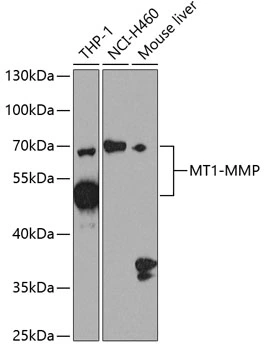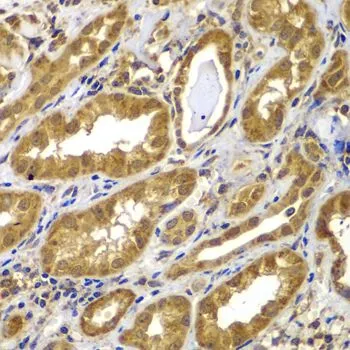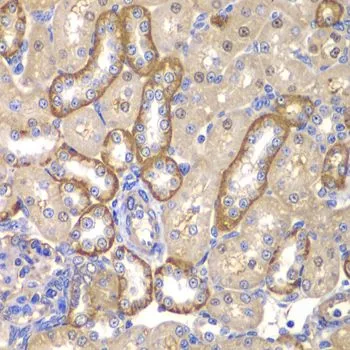
WB analysis of various sample lysates using GTX54361 MMP14 antibody. Dilution : 1:1000 Loading : 25microg per lane
MMP14 antibody
GTX54361
ApplicationsWestern Blot, ImmunoHistoChemistry, ImmunoHistoChemistry Paraffin
Product group Antibodies
TargetMMP14
Overview
- SupplierGeneTex
- Product NameMMP14 antibody
- Delivery Days Customer7
- Application Supplier NoteWB: 1:500 - 1:2000. IHC-P: 1:50 - 1:100. *Optimal dilutions/concentrations should be determined by the researcher.Not tested in other applications.
- ApplicationsWestern Blot, ImmunoHistoChemistry, ImmunoHistoChemistry Paraffin
- CertificationResearch Use Only
- ClonalityPolyclonal
- ConjugateUnconjugated
- Gene ID4323
- Target nameMMP14
- Target descriptionmatrix metallopeptidase 14
- Target synonymsmatrix metallopeptidase 14 (membrane-inserted); matrix metalloproteinase-14; membrane type 1 metalloprotease; membrane-type-1 matrix metalloproteinase; MMP-14; MMP-X1; MT1MMP; MT1-MMP; MT-MMP; MT-MMP 1; MTMMP1; WNCHRS
- HostRabbit
- IsotypeIgG
- Protein IDP50281
- Protein NameMatrix metalloproteinase-14
- Scientific DescriptionProteins of the matrix metalloproteinase (MMP) family are involved in the breakdown of extracellular matrix in normal physiological processes, such as embryonic development, reproduction, and tissue remodeling, as well as in disease processes, such as arthritis and metastasis. Most MMPs are secreted as inactive proproteins which are activated when cleaved by extracellular proteinases. However, the protein encoded by this gene is a member of the membrane-type MMP (MT-MMP) subfamily; each member of this subfamily contains a potential transmembrane domain suggesting that these proteins are expressed at the cell surface rather than secreted. This protein activates MMP2 protein, and this activity may be involved in tumor invasion. [provided by RefSeq, Jul 2008]
- Storage Instruction-20°C or -80°C,2°C to 8°C
- UNSPSC12352203
References
- Loss of MT1-MMP in Alveolar Epithelial Cells Exacerbates Pulmonary Fibrosis. Placido L et al., 2021 Mar 13, Int J Mol SciRead more




![IHC-P analysis of formalin fixed human placenta tissue using GTX52480 MMP14 antibody [9E10].](https://www.genetex.com/upload/website/prouct_img/normal/GTX52480/GTX52480_20191119_IHC-P_w_23060900_536.webp)
